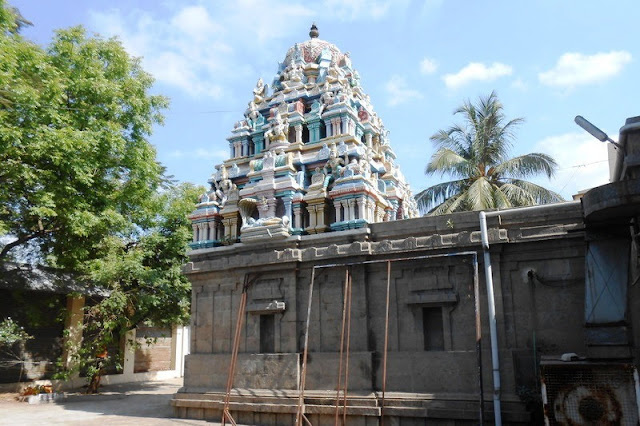Vaikuntavasa Perumal Temple, Koyambedu – The Temple
This east facing Temple is a much smaller temple
compared to the Kurungaleeswarar Temple. There is no Rajagopuram, but beautiful
Dasavathara images are found at the main entrance. There are many beautiful
sculptures all around the temple. Dwajasthambam, Garuda
and Palipeedam are at front on the outer prakaram facing towards the sanctum. Idols
of Valmiki, Lava & Kusa, Seetha in Maravuri and Alwars can be found in the Mahamandapam.
Daily pujas are performed to sage Valmiki.
Presiding Deity is called
as Vaikuntavasa Perumal and is facing east. Generally, Vaikuntavasa will be seen in a sitting pose
but here he is seen in a standing posture with his consorts Sridevi and
Boodevi. The main deity is being decorated differently on every Saturday. The
Utsavar is known as Azhagiyasingar and there is an unconfirmed report that the
Thelliyasingar deity in the Parthasarathy Temple at Tiruvallikeni, was kept
here during the alien invasion or due to some riots in the area.
The Utsavar is found flanked on either side by Sridevi
and Bhoodevi. The Utsavar images of the Goddess, Andal, Sudarsana, Azhwars,
Vishwaksenar and Ramanuja are also worshipped here. Procession deity appears
inviting the devotees by his left hand and blesses with the right. As he
is all graceful to the Devotees, he is called Bhaktavatsala – blessing the
devotees. It is believed that the tower of the temple is as the
shadow of the Lord, hence called Chaya Vimana-Shadow Vimana.
This temple is also famous for its shrine for Sri Rama
and Sita Devi. Sri Rama and Sita are found just outside the sanctum unusually
on normal clothing instead of being dressed like King and Queen. Lord Rama does
not appear in his Royal robe but in stark a dress made of plant stems and
leaves, a rare form. Sri Lakshmana and Sri Anjaneya are seen with
Lord Rama in Vishnu temples. Here only Rama and Sita are in the
temple. Later, a temple was built for Sri Anjaneya on the banks of
Lava-Kucha theertha.
Sita Devi is seen on a regular Saree with her hair do
(called Kodaali Kondai) as an ordinary woman. It is made to signify their
posture when they spent 14 years in the forest. In another place, Sita Devi is
also seen as a pregnant woman, as she gave birth to Lava and Kusa at Sage
Valmiki’s Ashram, after She was exiled to forest. Stucco Images of Lord Rama
fighting with his sons Lava and Kusa can be found in the Mukha Mandapam.
Mother is called as Kanagavalli Thayar. Goddess Kanagavalli Thayar is present in a separate
shrine on the outer prakaram at the southwest side of the temple. Goddess is so
beautiful, decorated with all Her ornaments. Sri Andal shrine is located at the
northwest corner of the temple. Sage Vaikasana, author of Vaikanasa puja codes
has an illustrious place in the prakara. There is a separate shrine
for Anjaneyar at the opposite side of the temple and by the side of 16 Pillar
mandapam of Shiva Temple, where Anjaneyar is seen facing west towards the temple.
There are 3 trees uniquely grown very close to each
other. There is one Vilvam tree between 2 neem trees on its either sides. It is
said that Vilvam signifies Lord Shiva and one of the Neem tree represents Sri
Parvathi and another Neem tree signifies her brother Lord Vishnu. It is
believed that it is like the wedding posture of Lord Shiva where Lord Vishnu
presides over their marriage by joining their hands together. A Vilvam and Neem
tree inside a Vaishnavite temple is a very rare sight. Sthala Vriksham is the
pipal tree.
The Theertham for this temple is ‘Lava Kusa Theertham’
which is believed to have been created by the two sons of Lord Rama. The same tank
serves as Theertham for Kurungaleeswarar temple, which lies just adjacent to
this temple. There is an ancient manuscript of the Ramayana in Telugu letters
and its title is Vaithya Ramayana and it is well preserved.














